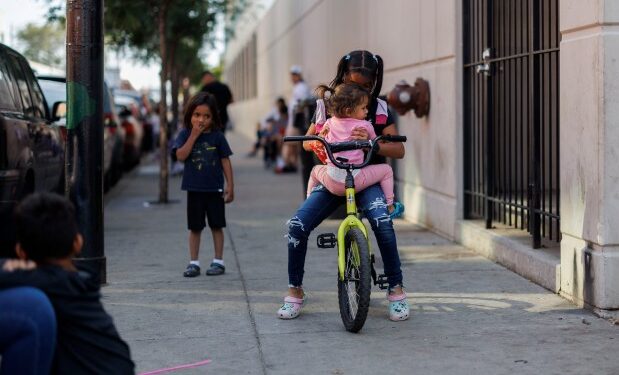The first year of high school is almost always marked by unknown variables: new classes, teachers, relationships and bus routes. But for Reynaldo Perdomo, 14, who has been forced to sleep in a truck after walking thousands of miles from Venezuela to make it to Chicago, his first month is clouded in uncertainty.
Monday night, Reynaldo came home and changed his clothes in a building across the street from the borrowed white Ford-150 where he sleeps with his father. He used wet wipes to clean himself. Later in the night, he climbed into the vehicle with his father and fell asleep, before getting up for school the next day.
Facing pressure to leave the shelter from city officials but wanting to stay near his son’s school, Reynaldo’s father Yohan Perdomo, 37, made the decision to sleep in the truck instead of move elsewhere.
“If I had a job, I would rent an apartment and move us there,” said Perdomo, who has struggled to find stable work for the past eight months to move them out of a migrant shelter on the Lower West Side.
For almost half a year, the city has enforced its 60-day policy to remove migrants from shelters. That policy was extended for families in March to ease the disruption on school-aged children. This school year, in an effort to condense shelters and save money, city and state officials are continuing to push children out, which worries immigrant and homeless advocates — and is crippling for families who have kids in school and are about to lose their homes.
And the city recently announced plans to close three of its largest shelters housing migrant families by October, according to Department of Family and Support Services spokesman Brian Berg. The shelters have capacity for 3,030 beds, he said. Out of 17 city and state shelters housing over 5,400 people, the three buildings currently hold 1,083, according to recent city data.
“The city is coordinating with Chicago Public Schools, Chicago Department of Public Health, state and county partners and wrap-around service partners to minimize disruptions to impacted families and ensure continuity of care,” Berg said in a statement Tuesday.
The decision came after the long-anticipated summer increase in arrivals did not materialize, in large part caused by a June executive order by President Joe Biden curtailing asylum claims at the border. The city has received close to 48,000 migrants in over two years and has spent more than $460 million to house and care for them. Due to the small number of arrivals from the border over the summer, there are now 5,000 extra beds.
All migrants will be offered shelter placements at other shelters where they will “continue to receive the same services,” said Berg, but the concept of condensing shelters doesn’t make sense for many who spoke to the Tribune.
Monday evening, Perdomo pointed at the shelter where he’s been staying and asked why he and Reynaldo were kicked out if there is ample space inside.

Weeks ago, he said they were given a 60-day notice from workers there. Reynaldo was already registered at Benito Juarez Community Academy several blocks away, as their exit date — Saturday, Sept. 7 — grew closer.
When the day finally arrived, Perdomo decided they would sleep in his friend’s truck to be closer to his son’s school, instead of moving.
“It would really hurt him to switch schools,” Perdomo said.
Under federal law, students without access to stable housing have the right to stay at the same school, even if they move from location to location. At CPS, students in temporary living situations are entitled to Ventra cards or yellow bus transportation to ease their transition.
The number of students enrolled under that designation at the end of the 2024 school year on June 6 skyrocketed to 23,447 — about a 44% increase from the prior year and more than ever recorded in an end-of-year report, according to data from the Chicago Coalition to end Homelessness.
The organization’s senior education attorney Alyssa Phillips believes this increase is directly caused by migrants coming to Chicago, though she said the number is an underestimate. While the district has done outreach, migrant families still may not register their students because they are scared of the potential ramifications on their immigration processes, she said.
“They aren’t familiar with the language or customs here,” Phillips said. “It’s going to be really hard to navigate the immigration system, the shelter system, your kids school system, (the) health care system.”
Phillips does not believe 60 days is enough time for a migrant family to find stable housing. She stressed that living in a transient state is hard for kids who have already missed a significant amount of school.
The city paused the shelter exit policy during the first two weeks of the school year, according to Berg. Those exits resumed around the same time as the announcement that three shelters would be closing this fall, leaving hundreds of kids in limbo.
The two shelters — on the Lower West Side and the West Loop — are expected to close by Oct. 1. A third shelter in Kenwood is expected to close by Oct. 24.
City officials said the closures are part of the beginning stages in their plan to have one unified system for both Chicago’s homeless population and migrants. On Friday, city officials held meetings on each floor of the West Loop shelter to spread the news about the closures, said Adriana Rodriguez, 16, from Venezuela. She and her three siblings have been in Chicago since late May.

Her family was told they had to go to a different shelter, about a 10-minute walk away. But she’d heard mixed things about that shelter, she said Monday afternoon outside the shelter. Rodriguez looked at her 10-year-old brother Eduardo Rodriguez, glued to his phone and balancing on a curb by the entrance to the shelter, and said the move would be especially difficult for him.
“He’s used to seeing the same people, the same workers, the same residents here,” she said.
Lena Fernandez, a single mother who arrived in Chicago in mid-May from Guayaquil, Ecuador, said she knew people living at the nearby shelter where they were supposed to move who found the environment hostile.
The new shelter, just a half-mile west, has received pushback from surrounding business owners and residents who say they’re being negatively impacted by the migrants. Fernandez has heard there is loitering there, frequent fights and even shootings.
“I would like to go to another shelter, but they decided to move us there,” she said. “I’m scared, but have nowhere else to go.”
Every time that a child has to move schools, it puts them about three to six months behind, said Patricia Rivera, founder of Chicago HOPES for Kids, a nonprofit that provides academic support for children experiencing homelessness.
“What we try to do is give support during the time that they’re experiencing homelessness, so that they don’t lose what they already gained,” she said.

Many migrant children — who come fleeing extreme violence and poverty in their countries of origin — already have to play catch up academically, said Rivera.
Rodriguez, for example, said she hadn’t been to school since they arrived in the city. Seven years ago, their family had moved to Colombia from Venezuela, and then life got so difficult they decided to trek thousands of miles to Chicago. Survival had become a bigger priority than education.
Outside the shelter on the Lower West Side Monday evening, Perdomo said he had stopped going to school in Venezuela when he was 16 because he needed to work. He was struggling financially there, but it hasn’t been much easier for him in Chicago. He said he had been at the shelter with Reynaldo since December and still couldn’t get a work permit.
His situation with Reynaldo is fine for now, but he worries about the colder winter months.
He loves being a dad, he said.
“It’s the most beautiful thing you could have in the world,” he said. “You just want the best (for your kid).”
Sitting in the bed of his truck, he watched Reynaldo cruise around on a bike modified with a small gas engine. Reynaldo revved the engine for effect, which made his father laugh.
They had worked on the bike to make it sound just like a motorcycle, he said.
Originally Published:







